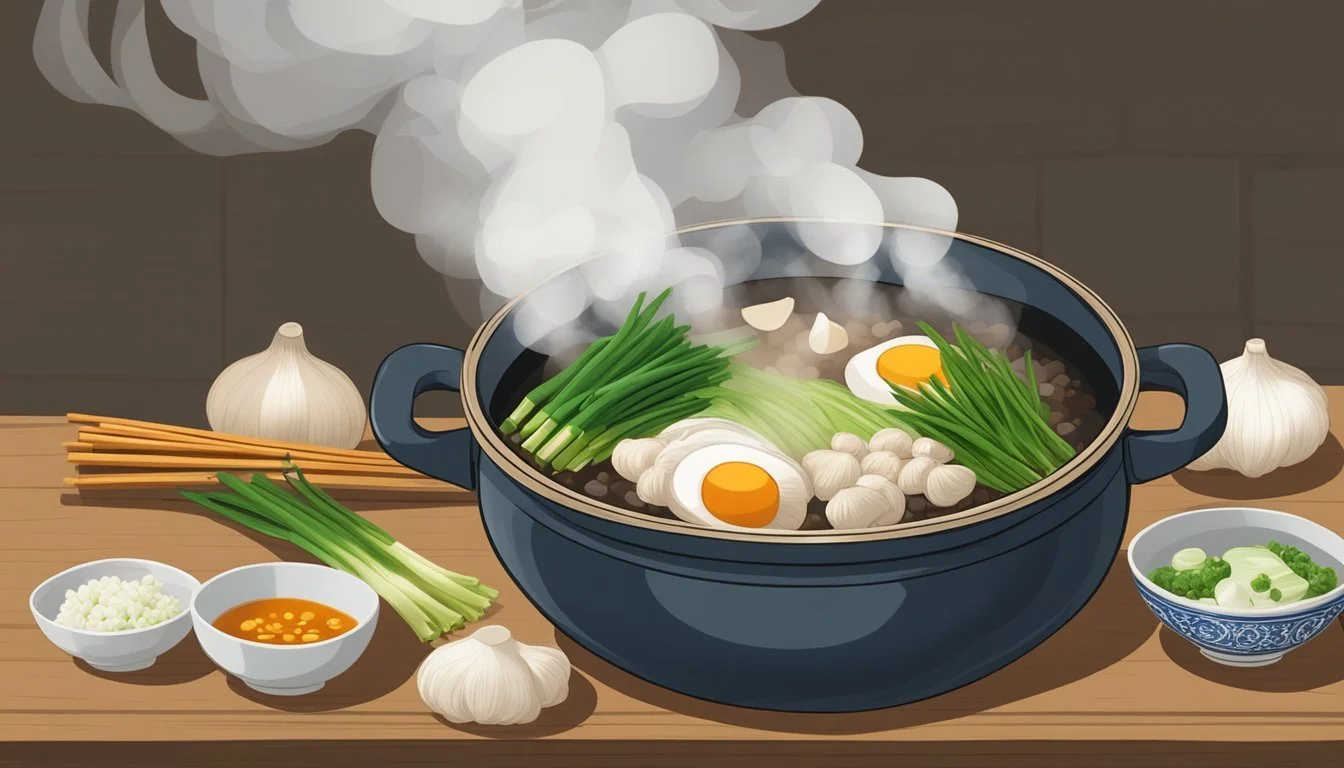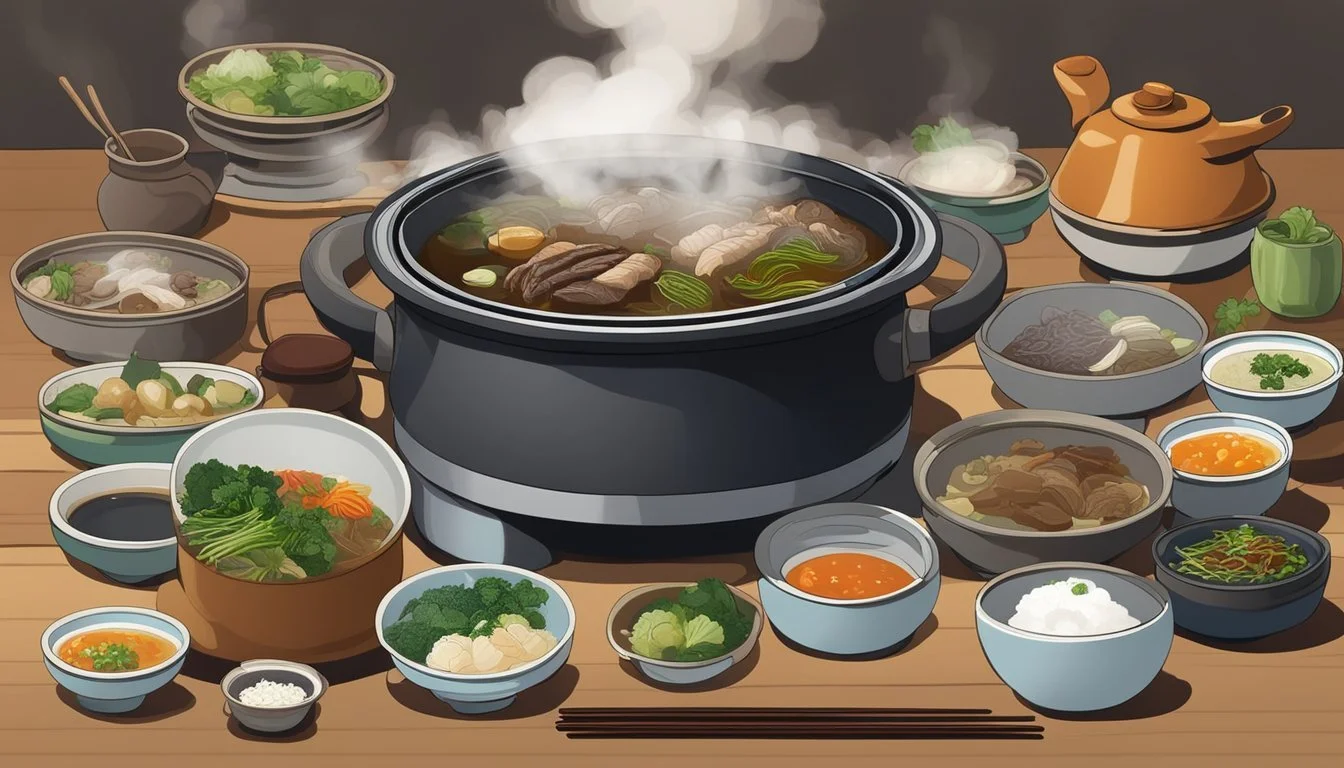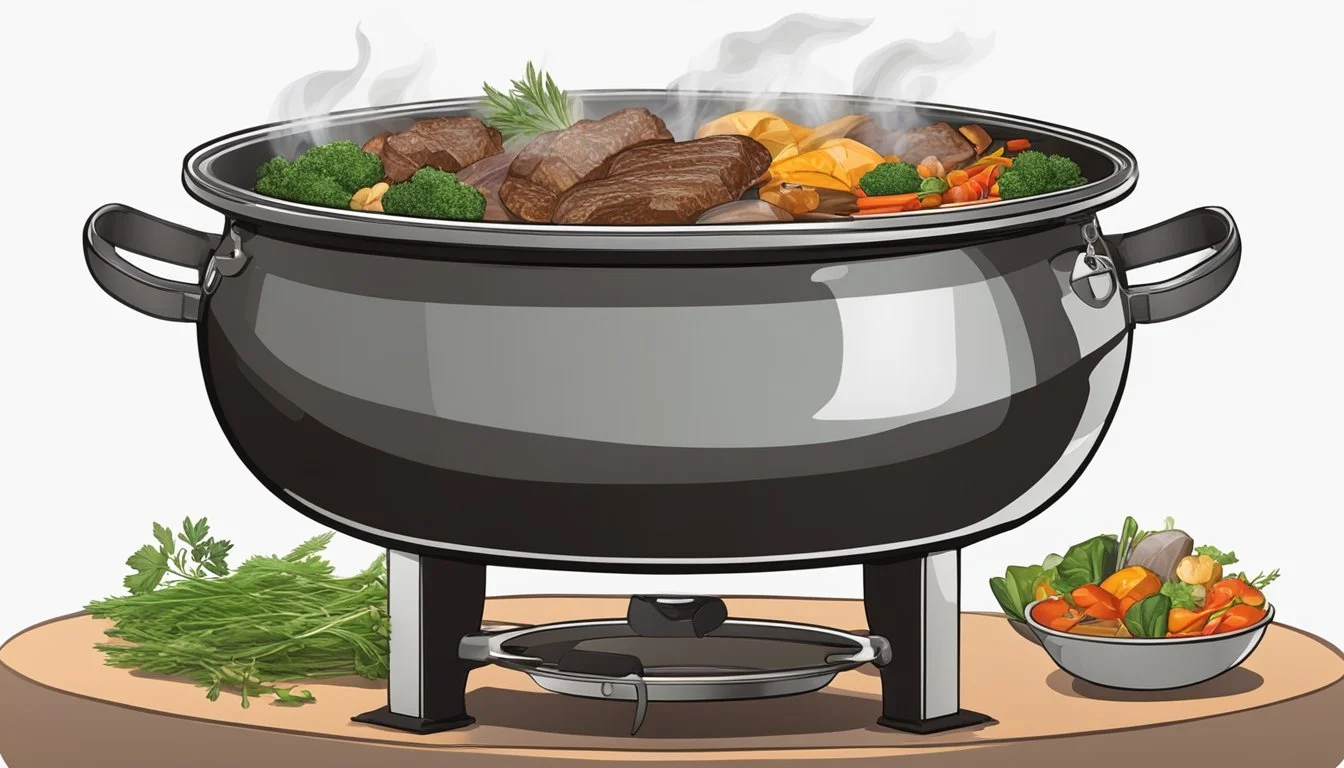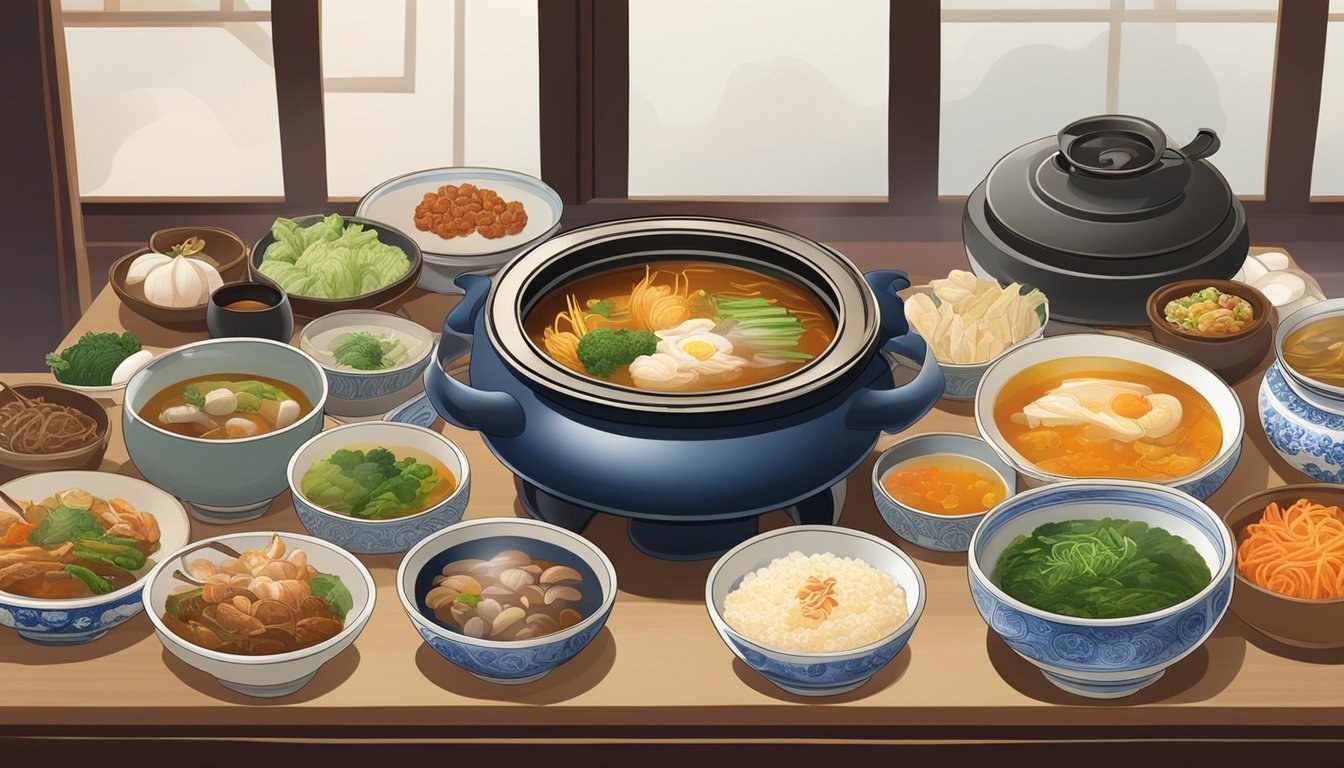Boshintang
Exploring the Historical and Social Nuances of Korean Cuisine
Boshintang, or invigorating soup, is a Korean dish with deep cultural roots. Composed chiefly of dog meat, typically boiled with a variety of vegetables like green onions, (What wine goes well with onions?) perilla leaves, and dandelions, this soup has been a part of Korean cuisine for centuries. With a complex flavor profile enhanced by traditional seasonings such as doenjang (soybean paste), gochujang (red chili paste), and perilla seed powder, the dish is finished with a touch of Agastache rugosa, also known as Korean mint, to bring a unique depth to its taste.
The culinary context of Boshintang is deeply intertwined with the Korean belief in its health benefits. Commonly consumed during the hottest days of the summer, known as sambok, it is associated with enhancing vitality and health. This practice aligns with the ancient principle of yiyeolchiyeol, or fighting heat with heat. The persistence of this traditional practice reveals the cultural complexity behind the consumption of dog meat in South Korea.
However, the preference for Boshintang and its principal ingredient, dog meat, has been evolving in South Korea. A growing sensitivity toward animal rights and shifting cultural norms have led to a decline in the dish's popularity. Moreover, younger generations, more exposed to international perspectives on animal welfare, are often less inclined to partake in this aspect of their culinary heritage, leading to an ongoing discourse about the future of this age-old tradition.
Historical Significance of Bosintang
Bosintang holds a notable place in Korean culture, with its roots deeply entwined in the nation's history. This traditional dish reflects the practices and culinary evolution of Korean society.
Origins of Dog Meat Consumption
The consumption of dog meat in Korea dates back to ancient times and is documented in various historical texts. One piece of evidence supporting the antiquity of this practice is a recipe from an 1849 book by the Korean scholar Hong Suk Mo. The consumption of dog meat is believed to have been prevalent during periods of war and famine when other meat sources were scarce.
Development as Korean Tradition
As a Korean culinary tradition, Bosintang evolved with the inclusion of typical Korean ingredients and cooking methods. The dish is historically associated with the belief in its health benefits, particularly its supposed qualities as an invigorating tonic. This perspective on dog meat as a health food contributed to the strengthening and persistence of the tradition of eating Bosintang in South Korea. It is typically prepared by boiling dog meat with various vegetables, such as:
Green onions
Perilla leaves
Dandelions
These ingredients are combined with traditional flavorings including doenjang (fermented soybean paste) and gochujang (fermented chili paste), to create a hearty soup. Despite its historical significance, one should note that contemporary Korean society is divided on this issue, and the consumption of dog meat has been declining as the society's attitudes toward animal welfare and pet ownership have evolved.
Preparation of Boshintang
Boshintang is a traditional Korean soup notable for its use of dog meat and rich, aromatic spices. Its preparation involves a precise combination of ingredients and cooking techniques that result in its unique flavor.
Ingredients and Spices
Ingredients:
Dog meat
Green onions (scallions)
Perilla leaves
Dandelion leaves
Spices and Seasoning:
Doenjang (fermented bean paste)
Gochujang (red chili paste)
Perilla seed powder
Garlic
Ginger
Sesame oil
The primary ingredient of Boshintang is dog meat, which is intertwined with other components such as perilla leaves, known for their mint-like flavor, and dandelion leaves. These elements work together to create a rich flavor profile. The soup is seasoned with a variety of spices including doenjang, a thick bean paste; gochujang, which adds piquancy; and a dusting of perilla seed powder for an earthy undertone. Additionally, garlic and ginger are essential for their aromatic properties, and sesame oil is used to introduce a nutty essence to the dish.
Cooking Methods and Variations
General Procedure:
The meat is first boiled to tenderize.
Aromatic vegetables and spices are added.
The mixture is simmered to allow flavors to meld.
Boshintang is typically prepared by an initial boiling of the dog meat to ensure tenderness. Aromatic vegetables such as scallions, and additional spices like garlic and ginger, are then introduced. This is accompanied by seasonings like doenjang and gochujang to develop a complex flavor. The cooking process allows time for these components to infuse the broth with the layers of flavor that are characteristic of Boshintang.
Variations may arise from the additional use of beef, other oils, or spices such as paprika, but the core components generally remain consistent to uphold the traditional qualities of the soup.
Cultural Perspectives and Practices
The Korean tradition of consuming dog meat has evolved over centuries, rooted deeply in historical beliefs and economic conditions. The practice displays a range of cultural nuances from perceived health benefits to its place in present culinary culture.
Culinary Status of Dog Meat in South Korea
Dog meat, known as 'Boshintang' or 'dog soup,' traditionally occupies a position in Korean cuisine, particularly during the summer months for its supposed invigorating qualities. Restaurants specializing in this dish reflect a culinary practice which is increasingly seen as controversial and is declining among the younger population. While historically prevalent, the consumption of dog meat is not universally accepted within South Korea today.
Supposed Health Benefits
The consumption of dog meat in Korea is in part due to the belief in its medicinal properties. Proponents argue that it possesses virility-enhancing qualities and consider boshintang an invigorating soup that helps to rejuvenate the body and maintain health during the sweltering heat of summer.
Symbolism and Cultural Beliefs
Dogs have held different symbolic statuses in Korean history, from protectors to sources of sustenance. Cultural beliefs surrounding dog meat consumption are often tied to seasonal festivities and the notion that it provides stamina and well-being. As societal values shift, these beliefs are subjected to scrutiny and are influencing changes within the culinary landscape.
Controversies and Legal Issues
The controversies surrounding boshintang are deeply intertwined with concerns for animal rights, rising international pressure, and evolving legal measures within South Korea.
Animal Rights and Welfare
Animal rights organizations, such as Humane Society International, have long condemned boshintang for animal welfare issues. The preparation of the dish has faced scrutiny due to the inhumane treatment of dogs, with activists emphasizing the need for more ethical treatment of animals. These organizations argue that the practice of consuming dog meat is not only cruel but also fails to meet the standards of humane slaughter.
The Illegality Debate
The legality of consuming dog meat in South Korea has historically been a gray area. Surveys and reviews of public opinion have shown a decline in the number of people supporting the consumption of dog meat. Despite this, until recent legislation, there was no explicit law declaring the production and sale of dog meat as illegal.
Government and Legal Response
The Korean government has responded to domestic and international pressure by passing legislation aimed at ending the dog meat trade. Parliament approved a law, set to be enforced by 2027, which will make breeding and slaughtering dogs for consumption illegal. This solidifies the government's stance on the matter, signaling a shift in cultural attitudes and aligning with a broader global consensus on animal welfare.
Societal and Global Perspectives
The consumption of dog meat, notably in dishes such as Boshintang, is an issue that draws diverse opinions within South Korea and intense criticism globally, reflecting a complex interplay between cultural tradition and animal rights.
Domestic Attitudes towards Dog Consumption
In South Korea, the tradition of eating dog meat has seen a notable decline in recent years. Surveys suggest a reduction in consumption, with only 8% of South Koreans reported to have eaten dog meat in the past year, compared to 27% in 2015. This change illustrates a shifting domestic stance, as younger generations and animal rights groups impact public opinion. The debate often centers on whether dog meat should be categorized as livestock similar to other animals consumed for food, or if it warrants special considerations due to the close relationship between humans and dogs.
International Views and Criticism
On the international front, eating dog meat has garnered substantial criticism. Organizations like the Humane Society of the United States have been vocal, characterizing the dog meat trade as cruel, focusing on alleged inhumane conditions during breeding and slaughter. Efforts to rescue dogs from such conditions have become part of international animal rights campaigns. The global discourse often contrasts the situation in South Korea with countries like North Korea, where the practice remains more common, and France, which has a historical context of consuming dog meat but has since outlawed the practice. The international community largely views the consumption of dog meat as a violation of animal welfare, pressuring for its abolishment.
Culinary Alternatives
In the context of Boshintang, traditional recipes are being updated with plant-based ingredients, attempting to maintain cultural significance while adapting to contemporary ethical standards.
Allied Recipes and Substitutions
Korean chefs are responding to changing societal views by creating plant-based recipes that offer similar flavors and health benefits without the use of dog meat. Primary Ingredient substitutions include a variety of vegetables and soy-based proteins.
For instance:
Soy Sauce and Doenjang (fermented soybean paste) continue to serve as essential flavoring agents, providing umami and depth to these new interpretations.
Scholars of Korean cuisine are exploring ways to replicate traditional tastes using ingredients such as mushrooms or tofu, which can mimic the texture of dog meat when cooked properly.
The Future of Korean Cuisine
As the culinary landscape evolves, there's a marked shift towards alternative proteins and creative use of traditional seasonings. The future of Korean cuisine shows a strong trend toward sustainability and ethical considerations, while still respecting the rich culinary heritage.
Conclusion
Bosintang has deep roots in Korean culinary traditions, stemming from beliefs in its health benefits and its historical role as a summer dish. Recent cultural shifts, however, indicate a steady decline in its consumption. The practice faces challenges from animal rights perspectives and changing social norms, particularly among younger Koreans who more commonly view dogs as pets rather than a source of meat.
In South Korea, there's an evident tension between preserving cultural customs and adapting to evolving ethical standards. As of now, no definitive resolution has been reached on the future of bosintang within the nation's culinary and cultural framework.
Outlook on Bosintang:
Public perception is increasingly negative.
Still consumed by certain demographics, but popularity is waning.
Cultural Preservation:
Opponents argue that some traditions can adapt in the face of modern ethical considerations.
Proponents of preservation stress the importance of maintaining historical continuity.
Whether or not bosintang remains a part of South Korean cuisine, understanding and respect for the complexity of the issue are paramount. The dish serves as a focal point for larger discussions about cultural identity and ethics in a rapidly globalizing world.






